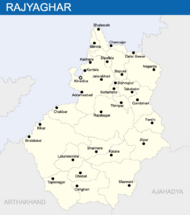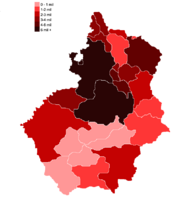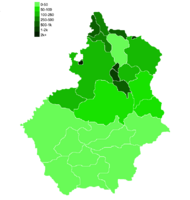Administrative divisions of Rajyaghar: Difference between revisions
mNo edit summary |
(Removed 'Regional Governors' and reduced powers of 'Union States and Federal Districts') |
||
| (6 intermediate revisions by the same user not shown) | |||
| Line 12: | Line 12: | ||
}} | }} | ||
{{Politics of Rajyaghar}} | {{Politics of Rajyaghar}} | ||
The '''Union States and Federal Territories''' of [[Rajyaghar]] are the principal administrative divisions of the Kingdom. The Kingdom is a {{wp|federation}} of | The '''Union States and Federal Territories''' of [[Rajyaghar]] are the principal administrative divisions of the Kingdom. The Kingdom is a {{wp|federation}} of 24 Union States and 2 Federal Territories. The Union States and Federal Territories are further subdivided into Provinces and Communes. | ||
[Brief history]. The administrative divisions are based on the historical [[Madhyarajyas|middle kingdoms]] of Rajyaghar with all of them retaining their royal families which serve as ceremonial representatives of the Monarch in the Union States and are granted the titles of ''"Rajakumar of the Union State"''. The Federal Districts are governed differently and have different ceremonial representatives of the Monarch. In [[Bishnupur]] it is the High Priest and in [[Kinadica]] it is the Governor. | [Brief history]. The administrative divisions are based on the historical [[Madhyarajyas|middle kingdoms]] of Rajyaghar with all of them retaining their royal families which serve as ceremonial representatives of the Monarch in the Union States and are granted the titles of ''"Rajakumar of the Union State"''. The Federal Districts are governed differently and have different ceremonial representatives of the Monarch. In [[Bishnupur]] it is the High Priest and in [[Kinadica]] it is the Governor. | ||
| Line 33: | Line 33: | ||
==Union States and Federal Territories== | ==Union States and Federal Territories== | ||
{{Rajyaghar labelled map|float= | {{Rajyaghar labelled map|float=right}} | ||
===Union States=== | ===Union States=== | ||
| Line 51: | Line 40: | ||
* {{flagicon image|RajyagharFlag.png}} [[Bhankari]] | * {{flagicon image|RajyagharFlag.png}} [[Bhankari]] | ||
* {{flagicon image|ChanakFlag.png}} [[Chanak]] | * {{flagicon image|ChanakFlag.png}} [[Chanak]] | ||
* {{flagicon image|DedhaFlag.png}} [[Dedha]] | * {{flagicon image|DedhaFlag.png}} [[Dedha]] | ||
* {{flagicon image|DelarBewarFlag.png}} [[Delar Bewar]] | |||
* {{flagicon image|RajyagharFlag.png}} [[Dharana]] | * {{flagicon image|RajyagharFlag.png}} [[Dharana]] | ||
* {{flagicon image|HarringhataFlag.png}} [[Harringhata]] | * {{flagicon image|HarringhataFlag.png}} [[Harringhata]] | ||
* {{flagicon image|RajyagharFlag.png}} [[Jhanaghar]] | * {{flagicon image|RajyagharFlag.png}} [[Jhanaghar]] | ||
* {{flagicon image| | * {{flagicon image|KendraPradeshFlag.png}} [[Kendra Pradesh]] | ||
* {{flagicon image|RajyagharFlag.png}} [[Kodur]] | * {{flagicon image|RajyagharFlag.png}} [[Kodur]] | ||
* {{flagicon image|LakhanaFlag.png}} [[Lakhana]] | * {{flagicon image|LakhanaFlag.png}} [[Lakhana]] | ||
| Line 67: | Line 56: | ||
* {{flagicon image|SanyuktFlag.png}} [[Sanyukt]] | * {{flagicon image|SanyuktFlag.png}} [[Sanyukt]] | ||
* {{flagicon image|RajyagharFlag.png}} [[Sangam]] | * {{flagicon image|RajyagharFlag.png}} [[Sangam]] | ||
* {{flagicon image| | * {{flagicon image|SanosraFlag.png}} [[Sanosra]] | ||
* {{flagicon image|RajyagharFlag.png}} [[Sasipur]] | * {{flagicon image|RajyagharFlag.png}} [[Sasipur]] | ||
* {{flagicon image|RajyagharFlag.png}} [[Suti]] | * {{flagicon image|RajyagharFlag.png}} [[Suti]] | ||
* {{flagicon image|RajyagharFlag.png}} [[Swarupnagar]] | * {{flagicon image|RajyagharFlag.png}} [[Swarupnagar]] | ||
* {{flagicon image| | * {{flagicon image|TarkhanaFlag.png}} [[Tarkhana]] | ||
* {{flagicon image|ZulmatFlag.png}} [[Zulmat]] | * {{flagicon image|ZulmatFlag.png}} [[Zulmat]] | ||
{{div col end}} | {{div col end}} | ||
| Line 77: | Line 66: | ||
===Federal Districts=== | ===Federal Districts=== | ||
There are 2 Federal Territories in the Kingdom of Rajyaghar: | There are 2 Federal Territories in the Kingdom of Rajyaghar: | ||
* {{flagicon image|BishnupurFlag.png}} [[Bishnupur]] | * {{flagicon image|BishnupurFlag.png}} [[Bishnupur]] | ||
* {{flagicon image|KinadicaFlag.png}} [[Kinadica]] | * {{flagicon image|KinadicaFlag.png}} [[Kinadica]] | ||
[[File: Regions Rajyaghar.png|150px|left|thumb|Ceremonial Regions]] | |||
===Ceremonial Regions=== | |||
The Kingdom of Rajyaghar can also be split into ceremonial regions which have no administrative function. These regions are groupings of similar union states based on geography, culture, history and language. | |||
The regions are: | |||
{{div col|colwidth=10em}} | |||
* Pavitra | |||
* the Core | |||
* the lowlands | |||
* Eastern Bloc | |||
* the Peninsula | |||
* the Outer Rim | |||
{{div col end}} | {{div col end}} | ||
== | ==Statistics== | ||
[[File: | [[File: RajyagharLocation.png|190px|right|thumb|Major Cities]] | ||
[[File: PopulationsRajyaghar.png|190px|right|thumb|States by Population totals]] | |||
[[File: RajyagharStatePopDensity.png|190px|right|thumb|States by Population Density]] | |||
{| class="wikitable sortable" | |||
!Division | |||
!Type | |||
!Region | |||
!Capital | |||
!Population | |||
!Area (km<sup>2</sup>) | |||
!Density (km<sup>2</sup>) | |||
|- | |||
|Bhankari | |||
|Union State | |||
|Pavitra | |||
|Bhalmore | |||
|800,538 | |||
|31,895 | |||
|25.1 | |||
|- | |||
|Bishnupur | |||
|Federal District | |||
|The Core | |||
|Bishnupur | |||
|3,160,018 | |||
|2,090 | |||
|1,512.0 | |||
|- | |||
|Chanak | |||
|Union State | |||
|The Lowlands | |||
|Chakbar | |||
|3,749,888 | |||
|29,200 | |||
|128.4 | |||
|- | |||
|Delar Bewar | |||
|Union State | |||
|Eastern Bloc | |||
|Delar Bewar | |||
|1,053,339 | |||
|549 | |||
|1,917.0 | |||
|- | |||
|Dedha | |||
|Union State | |||
|Pavitra | |||
|Chabat | |||
|724,697 | |||
|23,329 | |||
|31.1 | |||
|- | |||
|Dharana | |||
|Union State | |||
|The Core | |||
|Takshahn | |||
|3,876,289 | |||
|15,695 | |||
|247.0 | |||
|- | |||
|Harringhata | |||
|Union State | |||
|The Lowlands | |||
|Biratdakot | |||
|3,66,621 | |||
|111,984 | |||
|32.7 | |||
|- | |||
|Jhanaghar | |||
|Union State | |||
|Peninsula | |||
|Dipalbia | |||
|3,834,155 | |||
|9,223 | |||
|415.7 | |||
|- | |||
|Kendra Pradesh | |||
|Union State | |||
|The Core | |||
|Battarratta | |||
|5,679,606 | |||
|4,402 | |||
|1290.1 | |||
|- | |||
|Kinadica | |||
|Federal District | |||
|The Core | |||
|Kinadica | |||
|6,320,036 | |||
|876 | |||
|7,210.2 | |||
|- | |||
|Kodur | |||
|Union State | |||
|Pavitra | |||
|Lakshmimilla | |||
|800,538 | |||
|26,930 | |||
|29.7 | |||
|- | |||
|Lakhana | |||
|Union State | |||
|Peninsula | |||
|Bhalesrah | |||
|4,086,957 | |||
|9,481 | |||
|431.0 | |||
|- | |||
|Mondari | |||
|Union State | |||
|Pavitra | |||
|Katara | |||
|632,004 | |||
|30,829 | |||
|20.5 | |||
|- | |||
|Nakhtrana | |||
|Union State | |||
|The Core | |||
|Thimpar | |||
|4,508,292 | |||
|8,565 | |||
|526.3 | |||
|- | |||
|Parsa | |||
|Union State | |||
|Eastern Bloc | |||
|Farshi | |||
|1,558,942 | |||
|23,617 | |||
|66.0 | |||
|- | |||
|Pinjar | |||
|Union State | |||
|Outer Rim | |||
|Jitpur | |||
|1,390,408 | |||
|51,931 | |||
|26.8 | |||
|- | |||
|Rathankot | |||
|Union State | |||
|The Core | |||
|Rajabagar | |||
|7,499,776 | |||
|93,246 | |||
|80.4 | |||
|- | |||
|Raulia | |||
|Union State | |||
|Eastern Bloc | |||
|Qandahari | |||
|2,485,881 | |||
|31,110 | |||
|79.9 | |||
|- | |||
|Sangam | |||
|Union State | |||
|Outer Rim | |||
|Maswani | |||
|2,233,079 | |||
|69,619 | |||
|32.1 | |||
|- | |||
|Sanosra | |||
|Union State | |||
|Peninsula | |||
|Marola | |||
|3,960,556 | |||
|7,597 | |||
|521.3 | |||
|- | |||
|Sanyukt | |||
|Union State | |||
|The Core | |||
|Kentola | |||
|9,690,722 | |||
|86,976 | |||
|111.4 | |||
|- | |||
|Sasipur | |||
|Union State | |||
|Outer Rim | |||
|Cahghan | |||
|1,474,675 | |||
|38,806 | |||
|38.0 | |||
|- | |||
|Suti | |||
|Union State | |||
|Peninsula | |||
|Bapura | |||
|1,137,606 | |||
|24,510 | |||
|46.4 | |||
|- | |||
|Swarupnagar | |||
|Union State | |||
|Peninsula | |||
|Channajar | |||
|2,991,484 | |||
|5,269 | |||
|567,7 | |||
|- | |||
|Tarkhana | |||
|Union State | |||
|Outer Rim | |||
|Taplenagar | |||
|969,072 | |||
|45,112 | |||
|21.5 | |||
|- | |||
|Zulmat | |||
|Union State | |||
|Eastern Bloc | |||
|Nagarda | |||
|5,982,967 | |||
|50,570 | |||
|118.3 | |||
|- | |||
|} | |||
==State Governance== | ==State Governance== | ||
[[File: Admiral Verma.jpg|150px|right|thumb|Governor Siraskiar of Kinadica]] | |||
Governance of the Union States is divided between the [[Central Union Government|federal]] and state governments. Each Union State has a | Governance of the Union States is divided between the [[Central Union Government|federal]] and state governments. Each Union State has a {{wp|unicameral}} legislature. Following the {{wp|Westminster System|Northabbey model}}, the State Governments are led by First Ministers, who are members of the state legislature from the majority party. State elections are held every 5 years which, since 1995, have been at the same time as federal elections. | ||
Governance related to lower-level administration is further devolved from state governments to local authorities; the Provincial and Communal Councils. Whilst state governments hold jurisdiction over local authorities, the federal government can request the Monarch to invoke Article X of the Constitution, granting the Governor the right to intervene and potentially suspend the State Government. | Governance related to lower-level administration is further devolved from state governments to local authorities; the Provincial and Communal Councils. Whilst state governments hold jurisdiction over local authorities, the federal government can request the Monarch to invoke Article X of the Constitution, granting the Governor the right to intervene and potentially suspend the State Government. | ||
| Line 103: | Line 318: | ||
* Local planning and zoning | * Local planning and zoning | ||
* Education outside of the national curriculum | * Education outside of the national curriculum | ||
Since independence, the federal government has slowly reduced the powers granted to the state governments | Since independence, the federal government has slowly reduced the powers granted to the state governments, including amending the constitution to transfer any unprescribed powers from state governments to the federal government, which has led to increasing popularity of secession movements in the states of [[Tarkhana]], [[Sasipur]] and [[Pinjar]]. During ''the Emergency'', the 12th Amendment transferred jurisdiction of the police from state governments to the federal government. | ||
{{Rajyaghar}} | {{Rajyaghar}} | ||
Latest revision as of 19:16, 17 June 2021
This article is incomplete because it is pending further input from participants, or it is a work-in-progress by one author. Please comment on this article's talk page to share your input, comments and questions. Note: To contribute to this article, you may need to seek help from the author(s) of this page. |
| Union States and Territories of Rajyaghar | |
|---|---|
 | |
| Category | Federated state |
| Location | Kingdom of Rajyaghar |
| Number | 24 Union States, 2 Federal Territories |
| Government | State government |
| Subdivisions | Province, Commune |
 |
|---|
| This article is part of a series on the politics and government of Rajyaghar |
The Union States and Federal Territories of Rajyaghar are the principal administrative divisions of the Kingdom. The Kingdom is a federation of 24 Union States and 2 Federal Territories. The Union States and Federal Territories are further subdivided into Provinces and Communes.
[Brief history]. The administrative divisions are based on the historical middle kingdoms of Rajyaghar with all of them retaining their royal families which serve as ceremonial representatives of the Monarch in the Union States and are granted the titles of "Rajakumar of the Union State". The Federal Districts are governed differently and have different ceremonial representatives of the Monarch. In Bishnupur it is the High Priest and in Kinadica it is the Governor.
History
space filler - space filler - space filler - space filler - space filler - space filler - space filler - space filler - space filler - space filler - space filler - space filler - space filler - space filler - space filler - space filler - space filler - space filler - space filler - space filler - space filler - space filler - space filler - space filler - space filler - space filler - space filler - space filler - space filler - space filler - space filler - space filler - space filler - space filler - space filler - space filler - space filler - space filler - space filler - space filler - space filler - space filler - space filler - space filler - space filler - space filler - space filler - space filler - space filler - space filler - space filler - space filler - space filler - space filler - space filler - space filler - space filler - space filler - space filler - space filler - space filler - space filler - space filler - space filler - space filler - space filler - space filler - space filler - space filler - space filler -
Madhyarajyas
space filler - space filler - space filler - space filler - space filler - space filler - space filler - space filler - space filler - space filler - space filler - space filler - space filler - space filler - space filler - space filler - space filler - space filler - space filler - space filler - space filler - space filler - space filler - space filler - space filler - space filler - space filler - space filler - space filler - space filler - space filler - space filler - space filler - space filler - space filler - space filler - space filler - space filler - space filler - space filler - space filler - space filler - space filler - space filler - space filler - space filler - space filler - space filler - space filler - space filler - space filler - space filler - space filler - space filler - space filler - space filler - space filler - space filler - space filler - space filler - space filler - space filler - space filler - space filler - space filler - space filler - space filler - space filler - space filler - space filler -
Naratha Confederacy
space filler - space filler - space filler - space filler - space filler - space filler - space filler - space filler - space filler - space filler - space filler - space filler - space filler - space filler - space filler - space filler - space filler - space filler - space filler - space filler - space filler - space filler - space filler - space filler - space filler - space filler - space filler - space filler - space filler - space filler - space filler - space filler - space filler - space filler - space filler - space filler - space filler - space filler - space filler - space filler - space filler - space filler - space filler - space filler - space filler - space filler - space filler - space filler - space filler - space filler - space filler - space filler - space filler - space filler - space filler - space filler - space filler - space filler - space filler - space filler - space filler - space filler - space filler - space filler - space filler - space filler - space filler - space filler - space filler - space filler -
Colonial Era
space filler - space filler - space filler - space filler - space filler - space filler - space filler - space filler - space filler - space filler - space filler - space filler - space filler - space filler - space filler - space filler - space filler - space filler - space filler - space filler - space filler - space filler - space filler - space filler - space filler - space filler - space filler - space filler - space filler - space filler - space filler - space filler - space filler - space filler - space filler - space filler - space filler - space filler - space filler - space filler - space filler - space filler - space filler - space filler - space filler - space filler - space filler - space filler - space filler - space filler - space filler - space filler - space filler - space filler - space filler - space filler - space filler - space filler - space filler - space filler - space filler - space filler - space filler - space filler - space filler - space filler - space filler - space filler - space filler - space filler -
Union States and Federal Territories

Union States
There are 24 Union States in the Kingdom of Rajyaghar:
Federal Districts
There are 2 Federal Territories in the Kingdom of Rajyaghar:
Ceremonial Regions
The Kingdom of Rajyaghar can also be split into ceremonial regions which have no administrative function. These regions are groupings of similar union states based on geography, culture, history and language.
The regions are:
- Pavitra
- the Core
- the lowlands
- Eastern Bloc
- the Peninsula
- the Outer Rim
Statistics
| Division | Type | Region | Capital | Population | Area (km2) | Density (km2) |
|---|---|---|---|---|---|---|
| Bhankari | Union State | Pavitra | Bhalmore | 800,538 | 31,895 | 25.1 |
| Bishnupur | Federal District | The Core | Bishnupur | 3,160,018 | 2,090 | 1,512.0 |
| Chanak | Union State | The Lowlands | Chakbar | 3,749,888 | 29,200 | 128.4 |
| Delar Bewar | Union State | Eastern Bloc | Delar Bewar | 1,053,339 | 549 | 1,917.0 |
| Dedha | Union State | Pavitra | Chabat | 724,697 | 23,329 | 31.1 |
| Dharana | Union State | The Core | Takshahn | 3,876,289 | 15,695 | 247.0 |
| Harringhata | Union State | The Lowlands | Biratdakot | 3,66,621 | 111,984 | 32.7 |
| Jhanaghar | Union State | Peninsula | Dipalbia | 3,834,155 | 9,223 | 415.7 |
| Kendra Pradesh | Union State | The Core | Battarratta | 5,679,606 | 4,402 | 1290.1 |
| Kinadica | Federal District | The Core | Kinadica | 6,320,036 | 876 | 7,210.2 |
| Kodur | Union State | Pavitra | Lakshmimilla | 800,538 | 26,930 | 29.7 |
| Lakhana | Union State | Peninsula | Bhalesrah | 4,086,957 | 9,481 | 431.0 |
| Mondari | Union State | Pavitra | Katara | 632,004 | 30,829 | 20.5 |
| Nakhtrana | Union State | The Core | Thimpar | 4,508,292 | 8,565 | 526.3 |
| Parsa | Union State | Eastern Bloc | Farshi | 1,558,942 | 23,617 | 66.0 |
| Pinjar | Union State | Outer Rim | Jitpur | 1,390,408 | 51,931 | 26.8 |
| Rathankot | Union State | The Core | Rajabagar | 7,499,776 | 93,246 | 80.4 |
| Raulia | Union State | Eastern Bloc | Qandahari | 2,485,881 | 31,110 | 79.9 |
| Sangam | Union State | Outer Rim | Maswani | 2,233,079 | 69,619 | 32.1 |
| Sanosra | Union State | Peninsula | Marola | 3,960,556 | 7,597 | 521.3 |
| Sanyukt | Union State | The Core | Kentola | 9,690,722 | 86,976 | 111.4 |
| Sasipur | Union State | Outer Rim | Cahghan | 1,474,675 | 38,806 | 38.0 |
| Suti | Union State | Peninsula | Bapura | 1,137,606 | 24,510 | 46.4 |
| Swarupnagar | Union State | Peninsula | Channajar | 2,991,484 | 5,269 | 567,7 |
| Tarkhana | Union State | Outer Rim | Taplenagar | 969,072 | 45,112 | 21.5 |
| Zulmat | Union State | Eastern Bloc | Nagarda | 5,982,967 | 50,570 | 118.3 |
State Governance
Governance of the Union States is divided between the federal and state governments. Each Union State has a unicameral legislature. Following the Northabbey model, the State Governments are led by First Ministers, who are members of the state legislature from the majority party. State elections are held every 5 years which, since 1995, have been at the same time as federal elections.
Governance related to lower-level administration is further devolved from state governments to local authorities; the Provincial and Communal Councils. Whilst state governments hold jurisdiction over local authorities, the federal government can request the Monarch to invoke Article X of the Constitution, granting the Governor the right to intervene and potentially suspend the State Government.
The federal constitution outlines the following duties to be exercised by the state governments:
- Management of transportation and local infrastructure
- Provision of emergency services (excluding the police since 1965)
- Local planning and zoning
- Education outside of the national curriculum
Since independence, the federal government has slowly reduced the powers granted to the state governments, including amending the constitution to transfer any unprescribed powers from state governments to the federal government, which has led to increasing popularity of secession movements in the states of Tarkhana, Sasipur and Pinjar. During the Emergency, the 12th Amendment transferred jurisdiction of the police from state governments to the federal government.




